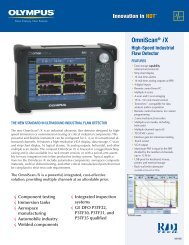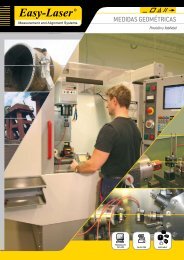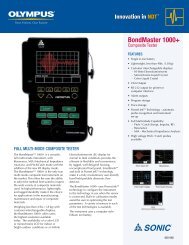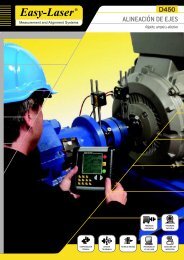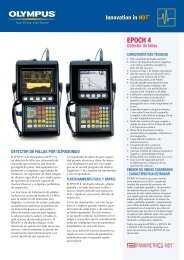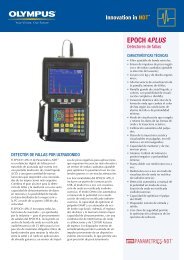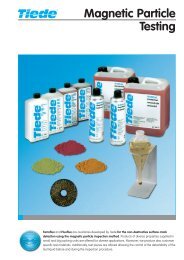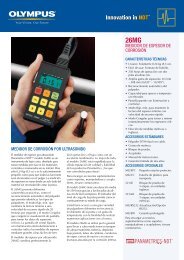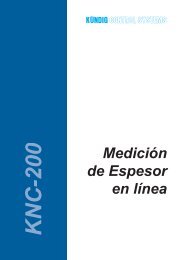Phased Array Ultrasonic Probe Catalog Phased Array ... - Tecsud
Phased Array Ultrasonic Probe Catalog Phased Array ... - Tecsud
Phased Array Ultrasonic Probe Catalog Phased Array ... - Tecsud
You also want an ePaper? Increase the reach of your titles
YUMPU automatically turns print PDFs into web optimized ePapers that Google loves.
ii<br />
Olympus NDT<br />
Olympus NDT is a leading global manufacturer of innovative<br />
nondestructive testing instruments that are used in a<br />
wide range of industrial and research applications including<br />
aerospace, energy, automotive, electronics, and manufacturing.<br />
Olympus NDT instruments contribute to the quality<br />
of products and add to the safety of infrastructures and<br />
facilities. They include flaw detectors, thickness gages, bond<br />
testers, pulser-receivers, transducers, and advanced systems<br />
for inline applications. Our leading-edge technologies include<br />
ultrasonics, ultrasonic phased array, eddy current, and<br />
eddy current array.<br />
Olympus NDT offers products and services from several<br />
high-quality brands: R/D Tech ® , Panametrics-NDT , NDT<br />
Engineering, Sonic ® , and Nortec ® . For many decades these<br />
brands have earned excellent reputations for providing<br />
cost-effective solutions and excellent support and customer<br />
service.<br />
Based in Waltham, Massachusetts, USA, the company has<br />
sales and service centers in all major industrial locations<br />
worldwide. Visit www.olympusNDT.com for application<br />
support and sales assistance near you.<br />
ISO 9001 Certification<br />
Olympus NDT <strong>Ultrasonic</strong> Transducer Inc. facility’s quality<br />
system is ISO 9001 certified, ensuring an increased level of<br />
quality, a controlled manufacturing process, and continuous<br />
improvement.<br />
understanding<br />
Basic Concepts<br />
The distinguishing feature of phased array ultrasonic testing is the computer-controlled excitation (amplitude<br />
and delay) of individual elements in a multielement probe. The excitation of multiple piezocomposite elements<br />
can generate a focused ultrasonic beam with the possibility of dynamically modifying beam parameters such as<br />
angle, focal distance, and focal spot size through software. To generate a beam in phase by means of constructive<br />
interference, the various active transducer elements are pulsed at slightly different times. Similarly, the echo from<br />
the desired focal point hits the various transducer elements with a computable time shift. The echoes received by<br />
each element are time-shifted before being summed together. The resulting sum is an A-scan that emphasizes the<br />
response from the desired focal point and attenuates echoes from other points in the test piece.<br />
Examples of focal laws<br />
Delay (ns)<br />
Incident wave front<br />
Active group<br />
16<br />
1<br />
Scanning direction<br />
PA probe<br />
Distance-amplitude curves (DAC) used to create<br />
the time-corrected gain (TCG)<br />
128<br />
45°<br />
Delay (ns)<br />
Angle steering<br />
For manual inspections, real-time readings are essential to quickly position the reflected signal source with<br />
respect to the part geometry and/or probe location.<br />
Top<br />
B0 Bottom<br />
T1 Top<br />
Incident wave front<br />
Illustration of beam focusing Illustration of beam steering<br />
PA probe<br />
�<br />
Acquisition unit<br />
Trigger<br />
Emitting<br />
Receiving<br />
n = 8<br />
Convex<br />
Delay (ns)<br />
PA probe<br />
<strong>Phased</strong> array unit<br />
Transmitting<br />
delays<br />
Receiving delays<br />
and sum<br />
Emission Reception Pulse-echo<br />
t 0<br />
t1<br />
t2<br />
t3<br />
tn<br />
Acquisition time<br />
RA<br />
PA<br />
DA<br />
RA, PA, DA, and SA readings allow the user to accurately<br />
position the defect in real time during an inspection.<br />
RA: Reference point to the indication in gate A<br />
PA: <strong>Probe</strong> front face to the indication in gate A<br />
DA: Depth of the indication in gate A<br />
SA: Sound-path length to the indication in gate A<br />
SA<br />
<strong>Probe</strong> elements<br />
Incident wave front<br />
Pulses<br />
Scanning Patterns<br />
Electronic linear scanning<br />
Sectorial scanning<br />
Dynamic depth focusing<br />
With electronic scanning, a single focal law is multiplexed across With sectorial scanning (also called azimuthal or angular<br />
Dynamic depth focusing (DDF) is a programmable, real-time array<br />
a group of active elements; scanning is performed at a constant scanning), the beam is moved through a sweep range for a response-on-reception accomplished by modifying the delay,<br />
angle and along the phased array probe length (aperture). This specific focal depth, using the same elements; other sweep gain, and excitation of each element as a function of time. DDF<br />
is equivalent to a conventional ultrasonic transducer performing ranges with different focal depths may be added. The angular replaces multiple focal laws for the same focal range created by<br />
a raster scan for corrosion mapping or shear-wave inspection. If sectors may have different values.<br />
the emitted beam with separate “focused beams” at the receiving<br />
an angled wedge is used, the focal laws compensate for different<br />
stage. In other words, DDF dynamically changes the focal distance<br />
time delays inside the wedge.<br />
as the signal returns to the phased array probe. DDF significantly<br />
increases the depth of field and signal-to-noise ratio.<br />
Electronic linear scanning Sectorial scanning<br />
<strong>Phased</strong> <strong>Array</strong> <strong>Probe</strong>s<br />
Linear arrays are the most commonly used phased array probes for industrial applications. Thus, one of<br />
the important features of linear arrays is the active probe aperture.<br />
The active aperture (A) is the total active probe length. Aperture length is given by the following formula:<br />
A = (n –1) •p + e<br />
e<br />
where n = Number of elements in the PA probe<br />
p = Elementary pitch—distance between the centers of<br />
two adjacent elements<br />
Wpassive<br />
e = Element width—width of a single piezocomposite<br />
element (a practical value is e < �/2)<br />
g = Gap between adjacent elements<br />
� =<br />
p<br />
g<br />
A<br />
v<br />
f<br />
where � = Wavelength<br />
v = Material sound velocity<br />
f = Frequency<br />
Time-Corrected Gain<br />
Defect Positioning<br />
70°<br />
60°<br />
45°<br />
70°<br />
60°<br />
45°<br />
70°<br />
60°<br />
45°<br />
In order to cover the whole volume of the part with<br />
consistency, each focal law has to be calibrated for<br />
attenuation and beam spread. This time-correctedgain<br />
(TCG) calibration can be performed with a<br />
calibration block having several identical reflectors<br />
(for example, side-drilled holes) at different depths.<br />
Using a sectorial scan, the probe is moved back<br />
and forth so that each beam hits each reflector. The<br />
amplitude of each signal is recorded (DAC) and<br />
used to construct one TCG curve per focal law.<br />
Linear<br />
Skewing<br />
1.5-D array<br />
Concave<br />
Variable angle<br />
Echo signals<br />
2-D array<br />
Annular<br />
Dual linear<br />
Flaw<br />
Reflected wave front<br />
<strong>Phased</strong> array probes are made in a variety of shapes and sizes for<br />
different applications. A few types are illustrated here:<br />
Flaw<br />
Acquisition without DDF Acquisition with DDF<br />
=<br />
Internal focus<br />
www.olympusNDT.com The leader in phased array technology for more than a decade<br />
Time delay [ns]<br />
140<br />
120<br />
100<br />
80<br />
60<br />
40<br />
20<br />
0<br />
FD = 15<br />
FD = 30<br />
FD = 60<br />
0 4 8 12 16 20 24 28 32<br />
Element number<br />
70°<br />
60°<br />
45°<br />
FD = 15<br />
FD = 30<br />
FD = 60<br />
Delay values (left) and depth scanning<br />
principles (right) for a 32-element linear<br />
array probe focusing at 15-mm, 30-mm,<br />
and 60-mm longitudinal waves.<br />
70°<br />
60°<br />
45°<br />
45°<br />
Dual 1.5-D<br />
70°<br />
60°<br />
45°<br />
Once the TCG calibration is completed, each focal law has one individual TCG curve. As<br />
a consequence, a reflector will always yield the same signal amplitude, regardless of its<br />
position inside the part and of the beam that detected it. A defect at 3 mm in depth detected<br />
with an angle of 45 degrees will provide the same signal amplitude as if it were at 10 mm and<br />
detected at 60 degrees.<br />
45°<br />
Types of<br />
<strong>Probe</strong>s<br />
Angle Beam<br />
Angle beam probes are used with a<br />
removable or integrated wedge to transmit<br />
a refracted shear or longitudinal wave into<br />
a test piece. They are designed for a wide<br />
range of applications and can be used to<br />
vary the refracted beam angle or the skew<br />
of the beam, depending on the wedge<br />
orientation. The probe face is acoustically<br />
matched to the wedge material.<br />
Integrated Wedge<br />
This variation of an angle beam probe<br />
integrates the wedge into the probe<br />
housing. The wedge configuration is fixed<br />
but offers smaller overall dimensions.<br />
Near Wall<br />
The near wall probe is specifically designed<br />
to minimize the dead zone at probe ends<br />
by reducing the distance between the last<br />
available element and the external edge of<br />
the housing. This probe type is useful for<br />
composite radius and corner inspections,<br />
or any application requiring close contact<br />
to a wall using a 0° wedge.<br />
Immersion<br />
Immersion probes are designed to<br />
be used with a water wedge or in an<br />
immersion tank when the test part is<br />
partially or wholly immersed. The water<br />
acts as a uniform couplant and delay line.<br />
Immersion probes are longitudinal-wave<br />
probes that can be set up for refracted<br />
shear-wave inspection under water.<br />
Immersion probes are mostly intended<br />
for automated inspections.<br />
Contact<br />
Contact probes are especially designed<br />
to be used directly in contact with the<br />
inspected material. They are longitudinalwave<br />
probes with a resistant wear face<br />
acoustically matched to steel.<br />
2-D and 1.5-D <strong>Array</strong>s<br />
Two-dimensional arrays have multiple<br />
strips of linear arrays to allow electronic<br />
focusing and steering in both probe<br />
axes. 2-D arrays have the same number<br />
of elements in both dimensions,<br />
whereas 1.5-D identifies probes with<br />
any combination of uneven numbers of<br />
elements. The probes can be used for<br />
achieving optimal focusing capability or<br />
to cover a defined area without probe<br />
movement.<br />
Dual <strong>Array</strong>s<br />
Two linear or two 1.5-D array probes can<br />
be positioned on a roof-angled wedge<br />
with a transmitting probe. The probe is<br />
paired with a receiving equivalent for<br />
optimal performance in noisy materials<br />
such as austenitic steel. This configuration<br />
is a phased-array equivalent to a dual-<br />
element probe in conventional UT and<br />
is widely used in the power-generation<br />
industry.<br />
Olympus NDT Training Academy<br />
<strong>Phased</strong> array training is available from<br />
professional companies.<br />
Visit www.olympusNDT.com<br />
Copyright © 2006 by Olympus NDT. All Rights Reserved.<br />
Warranty<br />
Olympus NDT Inc. offers a one-year warranty on all phased array<br />
probes sold. These products are guaranteed against all defects in<br />
materials and manufacturing.<br />
All products covered by this warranty must be examined by<br />
Olympus NDT Inc. and receive its approval in advance before any<br />
repairs or replacement are made. Any shipping costs are at the<br />
expense of the customer.<br />
The warranty excludes defects and deterioration due to normal<br />
wear and tear, or caused by an external accident such as:<br />
• Incorrect assembly<br />
• Poor maintenance<br />
• Incorrect usage<br />
• Exposure to temperatures outside the range of –20 °C to 60 °C<br />
for storage, or 10 °C to 40 °C for operation<br />
• Excessive voltage (max. 180 V for 7.5 MHz and below, max.<br />
100 V for 10 MHz and above)<br />
• Use of unqualified couplant<br />
• Unforeseen modifications of the product<br />
Olympus NDT will honor claims for defective products if submitted<br />
within 45 days from the date of shipment, provided that the<br />
product has not been improperly used and is subject to its inspection.<br />
Olympus NDT Inc. will not be held responsible in any way whatsoever<br />
for direct, indirect, special, incidental, or consequential<br />
damages resulting from possession, use, improper installation,<br />
accident, service, modification, or malfunction of the product<br />
(including, without limitation, damages for loss of business profits,<br />
business interruption, loss of business information, or other<br />
pecuniary loss), or from service or modification of the product by<br />
anyone other than Olympus NDT Inc. or an authorized Olympus<br />
NDT service center.<br />
Disclaimer<br />
This document was prepared with particular attention to usage to<br />
ensure the accuracy of the information contained therein. It corresponds<br />
to the version of the products manufactured prior to the<br />
printing date. There may, however, be some differences between<br />
the catalog and the products if the products have been modified<br />
thereafter.<br />
In order to support the growing NDT community, Olympus NDT has published the<br />
“Understanding <strong>Phased</strong> <strong>Array</strong> Technology” poster. This poster has been designed by field<br />
experts to present phased array technology in a concise and clearly illustrated manner.<br />
This poster will become a valuable resource for those who are responding to the large<br />
demand for phased array solutions.<br />
Get your free poster at www.olympusNDT.com.



